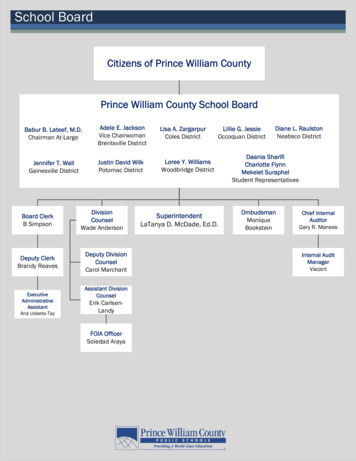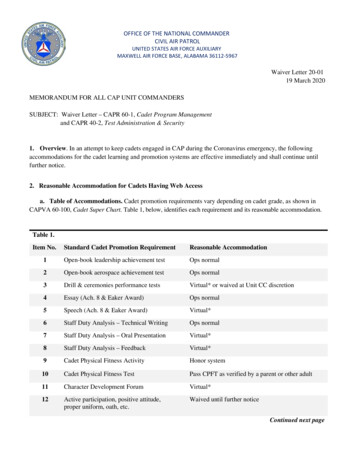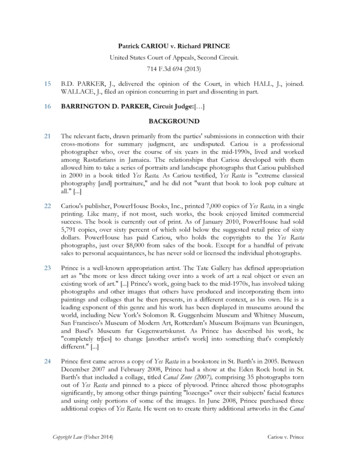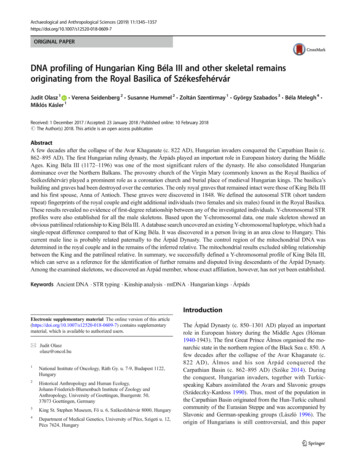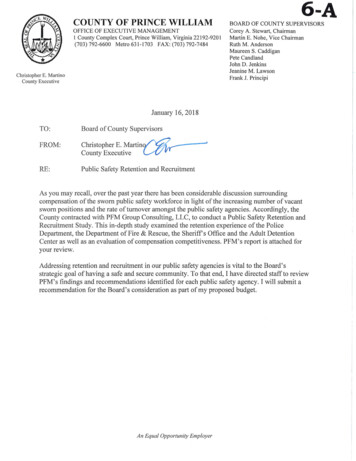
Transcription
6-APrince William County, VirginiaPublic Safety Retention & Recruitment StudyJanuary 16, 2018PFM Group Consulting, LLC1735 Market St43rd FloorPhiladelphia, PA 19103
I.ContentsI.Executive Summary . 4II.Organization of Report and Methodology . 8III.Recommended Options .13General Recommended Options .15Police Recommended Options .19Fire & Rescue Recommended Options .28Sheriff’s Office Recommended Options .37Adult Detention Center Recommended Options .43IV. Pay Plan Analysis and Comparison of Public Safety Pay Plans .51V.Retirement and Health Benefits .58VI. Police .66Summary of Findings .66Prince William County Police Compensation .68Northern Virginia Police Compensation .74Retention of Police Personnel .94Police Recruitment .129VII.Fire & Rescue Compensation, Retention, and Recruitment .143Summary of Findings .143Prince William County Fire and Rescue Compensation.145Northern Virginia Fire and Rescue Compensation.148Retention of Fire and Rescue Personnel .165Fire and Rescue Recruitment .193VIII.Sheriff’s Office Compensation, Retention, and Recruitment .205Summary of Findings .205Prince William County Sheriff’s Office Compensation .207Northern Virginia Sheriff’s Office Compensation.211Retention of Deputy Sheriffs .220Sheriff’s Office Recruitment .234IX. Adult Detention Center Compensation, Retention, and Recruitment .241Summary of Findings .241Prince William County ADC Compensation .243Northern Virginia Jail Officer Compensation .246Retention of ADC Personnel .256Recruitment.2782 Page
X.Appendix I. Discussion of Retention Best Practices.291XI. Appendix II. Public Safety Pay Scales .2933 Page
I.Executive SummaryThis report examines the retention experience of each of Prince William County’s four publicsafety employee groups – Police, Fire and Rescue, Sheriff’s Office, and the Adult DetentionCenter (ADC). While the retention experience of each public safety employee group is different– and driven by distinct factors – all County public safety agencies face challenges involvingcompensation competitiveness and employee satisfaction.To evaluate compensation competitiveness, the County’s compensation package and paystructures are benchmarked against a comparison group of regional Northern Virginia employers.Additionally, Prince William County public safety quit rates and turnover rates are compared withequivalent turnover data reported by other regional public safety agencies to provide context forinterpreting the County’s retention experience.To evaluate major external and internal factors that influence why public safety employees chooseto remain or leave County employment, insights were derived from a series of focus groups andonline surveys. Recruitment processes, as well as attitudes/perspectives of new recruits, wereevaluated as well.Based on the sum of these analyses, the project team developed a series of recommendedoptions for consideration that are designed to help preserve a competitive recruitment package,improve employee satisfaction, and stabilize the County’s public safety retention experience.While fiscal and operational concerns may require the County to prioritize among and/or modifythese recommended options, it is the sincere hope of the project team that this analysis helps toinform a positive path forward.Summary of FindingsFor any organization, recruitment and retention experience is driven by a mix of internal andexternal factors outlined in the figure on the following page. Such organizational dynamics arecomplex, and for Prince William County, the interplay of these dynamics is different in each publicsafety agency.4 Page
Internal and External Factors Affecting Recruitment and RetentionAs noted in the upper right-hand quadrant of the figure above, job satisfaction, compensationcompetitiveness, and retention are interconnected.Insights from focus groups and employee surveys indicate that compensation represents theprincipal factor driving Prince William County public safety employee attrition. While theparticulars vary – sometimes considerably – across each public safety employee group, threegeneral conditions contribute to Prince William County public safety employee dissatisfactionaround compensation: Pay compression, where employees with more tenure or a higher rank earn less basecompensation (or insufficient differentials) relative to less tenured employees. Lower pay levels for mid-career employees relative to other regional employers. An inability to project future earnings, where employees cannot clearly estimate earningsfive, ten, or fifteen years into the future.Generally, Prince William County offers competitive entry rates for each of the public safetyclassifications analyzed – police officer, fire and rescue technician, jail officer, and sheriff’s deputy.The County’s strong starting rate, supported by recruitment processes that are perceived5 Page
favorably by recruits and a positive reputation for the County’s public safety agencies, generatesa consistent pipeline of recruits.Prince William County public safety employees move through pay ranges over the course of acareer through a combination of pay-for-performance increases and market pay adjustments.While the County’s pay ranges are competitive to other regional employers, pay-for-performanceincreases may vary from year-to-year. In contrast, most public safety employers in the regionhave a well-defined pay progression (e.g., a pay scale) that allows employees to more easilyestimate future earnings.Since the end of the Great Recession wage growth in Prince William County has trailed otherregional employers. As a result, the actual pay levels for many Prince William County publicsafety employees – particularly those in the middle of a career – often lag their counterparts withthe same tenure in comparison jurisdictions.The comparatively slow wage growth experienced by Prince William County public safetypersonnel, coupled with the lack of a pay scale or similar pay progression, has led many earlyand mid-career employees to question whether they will reach the top of their respective payranges during their careers. This inability to project future earnings, in combination with paycompression and comparatively lower compensation levels, serve as motivation for many publicsafety employees to consider other employment opportunities.Consequently, within the first few years of service, Prince William County experiences increasedrates of voluntary resignations among public safety employees. Other drivers of these quit ratesvary by employee group, in part, according to internal and external factors specific to eachprofession. These factors are explored in greater depth in the subsequent chapters on eachpublic employee group.To address the conditions that contribute to employee dissatisfaction and turnover, this reportoutlines a set of options for the County to consider in the context of a revised long-termcompensation plan. The recommended options presented in this report address retentionconcerns on an issue-by-issue basis. However, any approach to address retention challengesfaced by County public safety employees should do so in a comprehensive, holistic fashion.Alleviating pay compression among current employees, for example, without addressing theunderlying structural conditions that caused pay compression, will lead to its re-emergence in thefuture.6 Page
Some of the highlights of the recommended options include: Implement targeted pay adjustments tailored to each public safety employee group.These adjustments would be added to base pay and targeted towards employees whoexperience the most severe pay compression.These adjustments could be implemented in two phases, as outlined in the scenariobelow: oFY 2019: Phase I targeted pay adjustment 3% pay-for-performance (pendingconsideration by Board of County Supervisors)oFY 2020: Phase II targeted pay adjustment 3% pay-for-performance (pendingconsideration by Board of County Supervisors)Develop pay scales for each public safety employee group to alleviate pay compressionpressures, help to align mid-career compensation more closely with regional comparisonemployers, and to provide a framework for employees to better project future earnings.o In the scenario listed above, all public safety employees would be migrated to apay scale by FY 2020 with the implementation of the Phase II targeted payadjustment.Streamline recruitment incentives and use slotting practices to align base compensationof new hires with prior experience, education, and/or certifications with more tenuredemployees, thereby alleviating pay compression for future hires.These recommended options have been designed to respond to concerns raised in the employeesurveys and focus group interviews. The employee survey data suggest that a large proportionof active employees favor a more structured, predictable pay plan where more tenured officersreceive higher pay levels.A total of 28 recommended options are presented in this report. They address both economicissues for each employee group (e.g., hiring practices at entry, pay premiums) as well as workingconditions (e.g., shift schedules). Taken as a whole, these options are anticipated to addressmany of the most pressing retention issues facing Prince William County’s public safety agencies,improve employee satisfaction, and mitigate employee turnover while maintaining a strongpipeline of future recruits.7 Page
II.Organization of Report and MethodologyThe central purpose of this study is to evaluate public safety employee retention in Prince WilliamCounty, and provide a series of recommended options designed to improve the County’semployee retention rates and job satisfaction.The following chapter (Chapter III) provides a detailed set of recommended options or initiativesdesigned to improve public safety retention and job satisfaction. These recommended optionsare categorized by public safety employee group. Chapter IV compares the structure of pay plansamong Northern Virginia jurisdictions to provide insight into how public pay plans – and publicsafety functions – are organized in the region. Chapter V presents Prince William County’sbenefits package, and provides comparisons with the Northern Virginia comparison group. Thesubsequent chapters (Chapters VI, VII, VIII, and IX) provide an overview of compensation foreach Prince William County public safety employee group, compensation comparisons withregional employers, insights from employee surveys, as well as an analysis of the Departments’recruitment efforts and perspectives from newly hired employees.Study MethodologyOver the course of the study, the project team used a variety of tools to evaluate Prince WilliamCounty’s retention experience. This evaluation included a variety of analytical and researchtechniques aimed at matching available data with current experience to arrive at the underlyingissues impacting the police and fire departments, as well as the Sheriff’s Office and the AdultDetention Center. These tools focused on Prince William County as well as outside agencies.The tools used in this study included: Interviews with Prince William County staff; Review of payroll data for each employee group provided by Prince William CountyDepartment of Human Resources as of 12/31/2016; 1 On-site interviews with uniformed personnel from each county public safety agency. Thisincluded multiple interviews and focus groups with public safety employees from recruitsthrough third-line supervisors, as well as, multiple meetings with command staff; Compensation and retention surveys of large Northern Virginia jurisdictions; Surveys of recruits, current employees, and separated employees (administered throughan online survey platform); and1Payroll runs for each employee group exclude employees with more than one year of completed service and worked fewer than2,080 annual hours in the Police Department, Sheriff’s Office, and Adult Detention Center and employees who worked fewer than2,184 annual hours in the Department of Fire and Rescue.8 Page
Employee exit surveys collected by the Police Department and Department of Fire andRescue.Northern Virginia ComparisonsFor retention and compensation comparisons, PFM compared Prince William Countycompensation to the largest local government employers in Northern Virginia – City of Alexandria,Arlington County, Fairfax County, and Loudoun County. These jurisdictions are the largest localgovernment employers in the region and compete for similar pools of potential employees. Assummarized in the table that follows, Prince William County’s household costs, income levels,rank towards the bottom of the Northern Virginia comparison group.Demographic/Economic Comparisons of Northern Virginia Jurisdictions ldIncomeAaa; AAA455,210 1,748 97,986Alexandria CityAaa; AAA155,810 1,733 87,920Arlington CountyAaa; AAA230,050 1,985 110,388Loudoun CountyAaa; AAA385,945 2,216 134,464Fairfax CountyAaa; AAA1,138,652 1,973 115,717Prince WilliamCounty Rank-2 of 54 of 54 of 5Median-307,998 1,979 113,053Variance-47.8%-11.7%-13.3%Bond Rating(Moody's; S&P)Prince WilliamCountyFor comparisons for jail officer compensation, the Rappahannock Regional Jail was added asanother point of reference. Though located in Stafford County, the Rappahannock Regional Jailis the closest multi-jurisdictional adult correctional facility in the region staffed by jailofficers/correctional officers, as opposed to deputy sheriffs.2Sources: Moody’s Investors Service credit ratings as of September 2017; Standard & Poor’s Financial Services (S&P) creditratings as of September 2017; U.S. Census Bureau, American Community Survey 2016, 1-Year Estimates; Metropolitan RegionalInformation Systems, Inc. (MRIS) Home Average Sold Price as of November 20179 Page
While police, fire/ems, deputy sheriffs, and jail officers all play critical and complementary roles inproviding public safety services to a community, their duties, responsibilities, skillset, and trainingrequirements vary considerably. Additionally, communities within Northern Virginia have chosendifferent organizational arrangements to provide these key services. The table below presentsthe job classification that provides services for each of seven public safety functions.Public Safety Functions in Northern VirginiaPublic Rescue/EMSPrince WilliamCountyPolice OfficerAlexandriaPolice OfficerDeputy SheriffArlington CountyPolice OfficerDeputy SheriffFirefighter/EMTFairfax CountyPolice OfficerDeputy SheriffFirefighterLoudoun CountyRappahannockRegional JailDeputy SheriffJail Officer(ADC)FirefighterDeputy Sheriffn/an/an/aFire/Rescue TechnicianMedic n/an/a* The City of Alexandria has a separate pay range and classification for medics. All uniformed fire/rescue personnel hired since 2014are cross-trained as firefighter/paramedics and the medic classification – though still in use for incumbents – is being phased outthrough attritionCompensation Approach (Total Direct Cash Compensation)To evaluate Prince William County compensation, PFM analyzed pay plans, job descriptions, andhad follow-up discussions with human resources personnel in each of the Northern Virginiajurisdictions surveyed. Based on this information, PFM compared public safety salary structuresfrom a total direct cash compensation perspective, at key career junctures (i.e., 5, 10, 15, 20, 25,and 30 years of service).Because different employers may take home pay through different components of thecompensation package, PFM uses the total direct cash compensation metric to adjust fordifferences in major cash premiums available to full performance public safety personnel, whereapplicable. Pay elements included in the total direct cash compensation comparisons include: Base pay Longevity/retention supplement Holiday payout10 P a g e
Scheduled overtime, uniform allowance, and shift differentialGiven that annual hours worked for fire and rescue personnel vary across Departments in theregion, PFM also evaluated standard schedule hours and major forms of paid leave (vacation,holiday leave, personal leave). Such allowances are subtracted from regularly scheduled annualhours to yield net hours worked. Total direct cash compensation is then divided by net annualhours to yield an hourly rate for total direct cash compensation per net hour worked.Career cash compensation analyses for Prince William County were based on payroll runseffective December 31, 2016. This approach captured the effects of historical freezes in pay-forperformance. To approximate actual pay levels by year of service in the comparison jurisdictions– which may not be reflected in fixed pay schedules or pay ranges – PFM applied historicalfreezes in step increments or merit increments in the comparison jurisdictions, where and whenthey occurred, in all career compensation comparisons.The compensation data presented are a snapshot based on 12/31/2016 payroll provided by theDepartment of Human Resources. A jurisdiction’s relative position in the comparison group maychange over time, and require regular evaluation. Some additional studies are underway aroundthe region that could have an impact on the County’s relative standing, but the details of suchchanges, if any, have yet to be determined.At the same time, this analytical framework does not include unscheduled overtime or othervariable premiums such as pay based on special assignments, or pay for special skills orcredential, nor does it include non-cash benefits. For total direct cash compensation tables,comparisons are shown on a 20-year, 25-year, and 30-year career average basis, which averagesthe pay received for each year of service on the current schedule.It is important to note that this methodology for determining pay yields an approximation ofearnings for a typical employee. Actual experience may vary based on shift distribution, historicalstep increases/pay-for-performance increases, recruitment incentives included in base pay, aswell as other factors such as specialty assignments.Survey DataTo provide insight on retention challenges, PFM developed separate surveys for benchmarkedjurisdictions, as well as Prince William County employee groups.For the Northern Virginia jurisdictions, PFM asked uniformed agencies to report public safetyheadcounts, separations for all causes, and resignations over the past five fiscal years. Somejurisdictions did report data for all employee groups for all years. From these data, PFM calculatedthe separation rates and quit rates presented in this study.Additionally, PFM developed a series of employee surveys for circulation to recruits, activeemployees, and separated employees. The goal of the surveys was to solicit input, insight and11 P a g e
perspectives on recruitment and retention issues facing each public safety agency. Themes inthe surveys were gleaned from issues raised by command staff, as well as topics surfaced infocus groups with various employee groups. The total number of surveys administered and theresponses received by category are provided in the table below.Survey Response RatesSurvey GroupNumberSurveyedResponsesReceivedResponseRate (%)Police Recruits474698%Police Current Employees588*36462%Police Separated Employees(includes retirees)2076029%Fire/Rescue Recruits30*2790%Fire/Rescue Current Employees550*42377%Fire/Rescue Separated Employees7457%ADC Pre-Academy Employees282279%ADC Current Employees27223486%ADC Separated Employees5647%Deputy Sheriff Current Employees1016362%Deputy Sheriff Separated Employees18950%* denotes an estimate provided by the department12 P a g e
III.Recommended OptionsThis chapter outlines a series of recommended strategic options that Prince William County mayconsider to address its public safety employee retention challenges. The PFM project teamfocused on drivers of attrition that surfaced in employee focus groups and surveys, and meetingswith Departmental command staff. Where appropriate, PFM benchmarked Prince William Countypractices against the Northern Virginia comparison group – the City of Alexandria, ArlingtonCounty, Fairfax County, and Loudoun County. For Adult Detention Center (ADC) comparisons,the Rappahannock Regional Jail was included in the comparison group as it is the nearest multijurisdictional detention facility staffed by correctional officers/jail officers (as opposed to deputysheriffs).The most salient issues articulated to the project team revolved around compensation – paycompression, pay levels, and the inability to project future earnings. Accordingly, many of therecommended options listed in the following pages – if enacted – will entail an increase in coststo the County.The recommended options are designed to align with a series of compensation related guidingprinciples articulated to the project team by County leadership: Create a clear compensation path for public safety employees throughout the duration ofa career. Strive to provide equal pay-for-performance increases across all public safety employeegroups. Create or maintain competitive entry rates to retain a strong pipeline of recruits for eachpublic safety career path. Attempt to close pay gaps with key regional competitors. Preserve budgetary flexibility in future years.Recommended options and findings listed below are presented as a “menu of options” andrepresent a series of ideas designed to improve the County’s retention experience while retaininga strong recruitment package. These recommended options must be considered within thecontext of the County’s overall budget resources, constraints, and priorities. This considerationmay, appropriately, lead to some recommended approaches being prioritized over others, and/ortailored to fit within available resources, and/or implemented over time as resources allow.Additionally, many of these recommended options require changes to Departmental practicesand/or approval by the Board of County Supervisors.Where possible, general cost estimates are provided for recommended options. These costestimates reflect base pay only, are based on the payroll data run effective December 31, 2016with simplifying assumptions, and are shown to represent the potential order of magnitude for13 P a g e
each recommended option. Additional analysis will be required to perform updated and refinedcost estimates of each recommended option.The first section of this chapter presents a series of recommended options that touch all publicsafety employee groups. The subsequent sections provide additional detail on specificrecommended options for each public safety employee group. The final section presentsadditional options for the County to consider that target employee satisfaction, and may haveindirect effects on improving retention rates.14 P a g e
General Recommended OptionsRecommended Option #1: Implement targeted pay adjustments for each public safetyemployee group to address pay compression and improve market competitivenessTargeted pay adjustments are designed to address pay compression, align tenure with yearsof service at the Department, and improve the County’s relative position with regional publicsafety agencies. In focus groups and employee surveys, pay compression and lagging paylevels relative to other regional departments are common themes for voluntary resignations andemployee dissatisfaction. The targeted pay adjustments address each of these concerns.All public safety employee groups show evidence of pay compression within their compensationplans. Pay compression occurs when there are inadequate pay differentials betweenemployees within the same rank or between employees in subordinate and supervisory ranks.In some instances, employees with longer tenure earn lower base pay than employees withless tenure.To address pay compression, targeted pay adjustments are designed to align basecompensation with tenure, target pay increases towards employees whom have experiencedthe slowest wage growth since the Great Recession, and alleviate pay compression acrossranks.Additionally, the pay adjustment will improve the County’s relative position with public safetyemployers in the region. While the County’s pay ranges are competitive relative to the NorthernVirginia comparison group; as a whole, Prince William County public safety employees havemoved more slowly through their pay ranges relative to public safety employees in the regionsince the Great Recession. As a result, the actual pay levels for many Prince William Countypublic safety employees – particularly those in the middle of a career – often their counterpartswith the same tenure in comparison jurisdictions. Accordingly, the targeted pay adjustments,in concert with regular pay-for-performance increases (presuming Board of County Supervisorsapproval), are designed to accelerate employees through existing pay ranges.The dollar amount of the targeted pay adjustment received by each employee will depend onthe following factors: Public safety employee group; Tenure; Base pay (inclusive of applicable recruitment incentives and supplemental pays rolledinto base pay); and Rank.The recommended pay adjustments listed in the pages that follow are:15 P a g e
Implement targeted pay adjustments that are designed to primarily address paycompression and direct resources to employees who experienced the slowest wagegrowth since the Great Recession, as well as improve market competitiveness. Move all employees to a pay scale with 3% step increments over a multi-year timeperiod, in concert with addressing Department-specific compensation and relatedoperational issues.The targeted pay adjustments may be phased-in over a multi-year period in concert with 3%annual pay-for-performance increases, if authorized by the Board of County Supervisors. Suchapproach would yield meaningful year-over-year wage increases for the vast majority ofemployees, while simultaneously addressing issues with pay compression and regionalcompetitiveness.For example, one scenario would entail delivering the targeted pay adjustments and pay-forperformance increases over two fiscal years: FY 2019: Phase I targeted pay adjustment 3% pay-for-performance (pendingconsideration by Board of County Supervisors) FY 2020: Phase II targeted pay adjustment 3% pay-for-performance (pendingconsideration by Board of County Supervisors)In the scenario listed above, all public safety employees would be migrated to a pay scale byFY 2020 with the implementation of the Phase II targeted pay adjustment.Additionally, for agencies that provide recruitment incentives that are rolled into base pay (i.e.,Police, Sheriff’s Office, and ADC), the streamlining of these incentives is recommended as well.Streamlining recruitment incentives will alleviate pay compression among new hires. Thespecifics of these recommended options
Detention Center. These tools focused on Prince William County as well as outside agencies. The tools used in this study included: Interviews with Prince William County staff; Review of payroll data for each employee group provided by Prince William County Department of Human Resources as of 12/31/20161;

